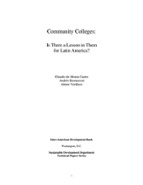Community Colleges: Is There a Lesson in Them for Latin America?
Date
Oct 2001
As secondary education in Latin America and the Caribbean expands its reach and more attention is given to the post-secondary level, new demands are placed on educators and ministries. New methods of teaching will have to be found, new markets for graduates will have to be identified, and better targeting mechanisms for matching students with the market's real demand for labor will have to be defined and implemented. In short, the very definition of secondary and post-secondary education will have to be reexamined. It is in this regard that the community college model prevalent in the United States and Canada merits closer examination. Several countries in Latin America and the Caribbean have experience introducing short post-secondary courses and nonuniversity institutions, sometimes as a result of private initiative, sometimes as a matter of public policy. Europe and North American models have inspired these innovations. Yet, this paper contends that more needs to be done in this area, in all countries and it explores in depth the model of the community college as an interesting source of ideas and relevant responses to changes in the social and economic landscape of the region. It also explores the potential the community college model holds for Latin America. The author's hope is that countries and institutions will look at this model not as something that should be necessarily imitated, but for inspiration and as an opportunity to reflect on the relevance and effectiveness of the current supply of post-secondary education and training.



